LED Ceiling Lamps: types, selection criteria, best manufacturers
Decided to replace incandescent lamps with more economical diode devices? The prospect of getting well-organized coverage while saving on utility bills is quite tempting. Is that right? But you don’t know how to choose LED ceiling lights and which manufacturer to prefer?
We will help you deal with LEDs for ceiling lights. The article discusses the types of devices, their pros and cons. Criteria for choosing the best option are given taking into account the expected effect of new bulbs.
To make a choice, visual illustrations and video recommendations attached to the article will help. It will contribute to the listing of the best manufacturers with a reputation in the lighting market. Based on our advice, you can make a balanced purchase.
The content of the article:
What is an LED fixture?
The operation of the products is based on the principle of electrical luminescence. A current flow passes along the boundary of two different semiconductors. At this moment, electromagnetic radiation is released that lies in the color spectrum visible to the human eye.
Structurally, the lamp consists of a housing, inside of which there are semiconductor light sources, a scattering lens, a cooling radiator, and Power Supply (driver).
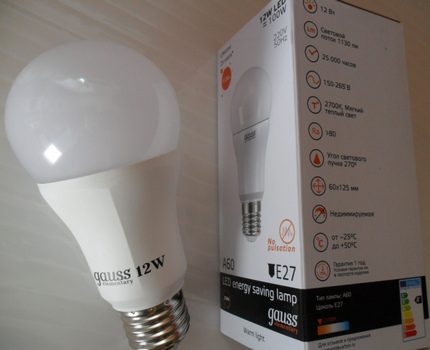
The first LEDs had a distinctly red tone of glow and were extremely expensive.When the elements of blue were invented, the lamps became significantly cheaper and became available for the widest application in industry and everyday life.
Types of lamps for the ceiling
Ice lamps for ceiling lighting are produced in the most unusual configurations and vary in the type of cap. Screw products have screw threads at the bottom and are marked with the letter “E”. Next to it are usually numbers showing the base diameter of the threaded connection.
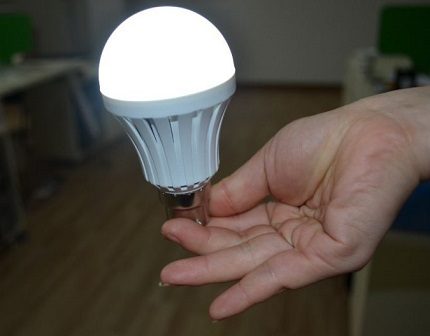
The second type of cap is called pin and is marked with the letter "G". Structurally, it is two small metal antennae, playing the role of electrical contacts. With their help, the lamp is tightly mounted in the lamp holder and is firmly held there throughout the entire working period.

The remaining socles, denoted by the letters B, R, P, S, K, T, W have a more narrowly specialized focus and are used much less frequently in everyday life.
What to look for when choosing?
LED-based ceiling lamps are distinguished by the following important criteria:
- supply voltage;
- operating current level;
- base power;
- light efficiency;
- shade (temperature) of the supplied light flux;
- radiation angle;
- shape and size;
- period of degradation.
All these nuances must be considered when buying. Only they will help you make the right choice and purchase a device that exactly meets all the requirements that a client makes for a home lighting system.
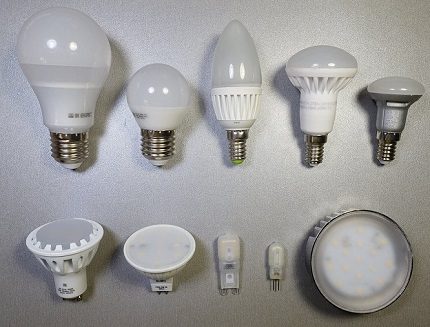
If you ignore any of the above points, the cost of financial resources for the acquisition will be in vain, and in the living room it will not be possible to create the necessary level of coziness and comfort. LED light bulbs general household purposes have a working power of 3 to 15 watts.
Similar indicators for modules intended for industrial use reach 100 watts. The emitted light stream demonstrates high intensity and, at the lowest possible cost, electricians can illuminate rooms of any size.
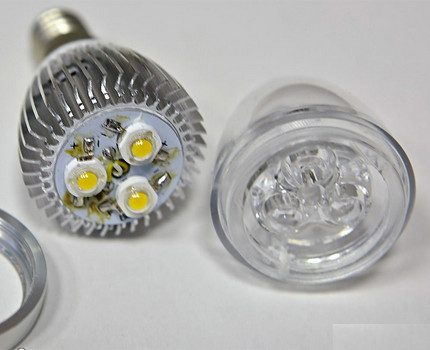
The efficiency of the products is 90%, and in this parameter led-products are significantly ahead of any other light sources.
Criterion # 1 - the temperature of the generated light
The luminescence spectrum of all supply sources is divided into three main groups according to color temperature. The first includes elements that produce warm white light (Warm white), very similar to the effect of a classic incandescent lamp.
They operate in the temperature range from 2700K to 3200K and are recommended for operation in residential premises.
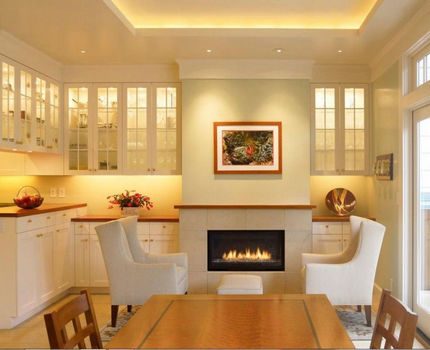
The second group includes a spectrum from 3500K to 5000K. This light is called normal or daylight white (Neutral white) and visually resembles the shade of the morning sun glow of good brightness.
It is perceived by the eye as neutral and is excellent for use in technical rooms of a house or apartment, in offices, classrooms and classrooms, production halls, etc.Experts point out that neutral lighting helps increase efficiency, helps concentration and does not lead to eye fatigue.
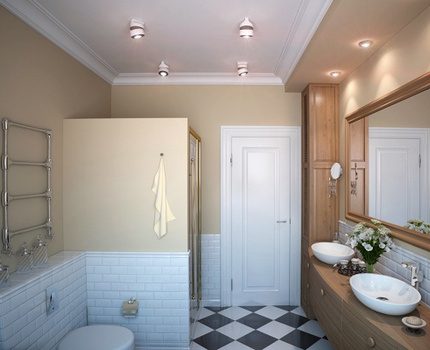
In the range from 5000K to 7000K there are cool white lamps that produce very bright daylight (Cool white) In living rooms they are practically not used.
Basically, such modules are used in hospital buildings, laboratories, corridors and in technical premises.
Criterion # 2 - an indicator of the angle of radiation
Such an important parameter as the angle of radiation for lamps of different manufacturers ranges from 20 to 360 degrees. This means that the LEDs shine more brightly in the center, and to the edges of the scattering angle they reduce the level of illumination.
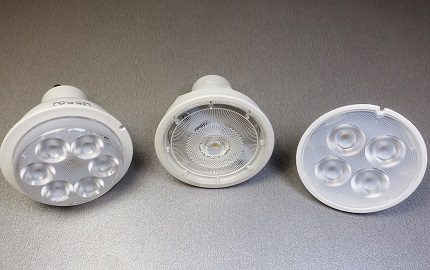
This principle of operation makes it possible to ensure high-quality supply of light to a specific space, spending significantly less power on the task. If there is a need to increase the useful illuminated area, an additional scattering lens is built into the lamp.
Criterion # 3 - marking of a dimensional ruler
All manufacturers of LED ceiling products produce lamps of fundamentally different sizes and configurations.
The most common are the following forms:
- A - corresponds to the appearance of a classic incandescent lamp;
- B - resembles an oval with a blunt end;
- C - looks like a candle flame;
- CA - called a “candle in the wind” and has a slightly pointed edge bent to the side;
- Cw - It looks like a candle twisted in one direction;
- G - is a traditional ball;
- E - is an elongated ellipse;
- R - equipped with a reflector (reflector);
- BR - has a convex reflective surface and a slightly larger size than the R-module;
- Mr - equipped with a mirror reflector;
- PAR - has a reflector of an unusual parabolic shape;
- T - is made in the form of a tube, on the surface of which the working LEDs are located.
It is such ice lamps that are most popular and are most often used for arranging domestic and home comfortable lighting systems.
Criterion # 4 - glow degradation time
The decrease in the intensity of the lamp over time is a natural process caused by turbidity of the crystals during prolonged use. Professionals call it degradation. When this happens, the efficiency of the lighting element decreases and the light saturation of the stream noticeably weakens.
In LED products of well-known brands, the light intensity decreases closer to the end of the declared service life. Unnamed Chinese-made modules are more prone to this and may begin to fade already at the very beginning of their work.
Advantages and disadvantages of LED-lamps
Lamps operating on LED elements have a whole range of unique advantages that allow them to be used not only exclusively for lighting, but also for organizing an original and unique atmosphere in rooms.
With the help of these progressive tools, you can give bright accents even to the simplest interior and make an ordinary room stylish and exclusive.
Pluses of products on LEDs
The operating temperature is so low that it can be positioned in close proximity to materials that are flammable or prone to melting.
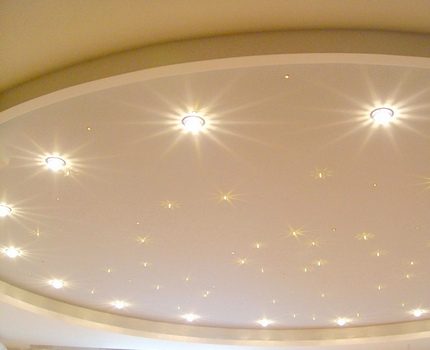
The option of adjusting the direction of the light flow makes it possible to make zone lighting in the room, emphasizing the style and originality of the design decision.
In this version, some places will be highlighted brighter, while others will go into the shade and gain some intimacy and intimacy.
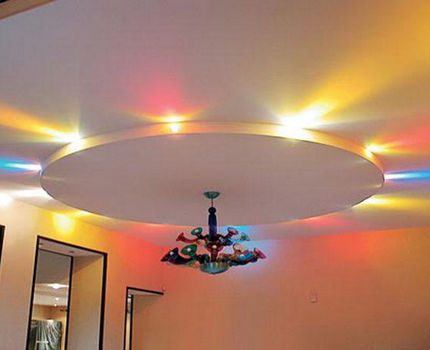
Another indisputable plus is expressed in the resistance of LEDs to cyclic load. They easily withstand a huge amount of activation, immediately flare up at full power when turned on and instantly go out when the user presses the “off” button.
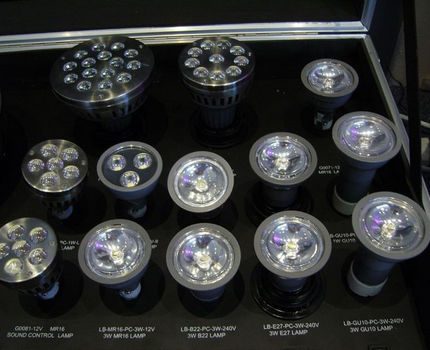
The ability to economically consume electrics also adds points to Led bulbs. They consume 20 times less electrics than similar classic appliances, while giving out lighting of the same power.
LED life is measured in hundreds of thousands of hours. They burn for a record long without replacement, without forcing the owner to constantly spend money on the purchase of new lamps. The absence of UV radiation is one of the very attractive features of LEDs.
Working indoors even for a long time, they do not provoke burnout of furniture upholstery, do not contribute to the dimming of wallpaper and do not cause cracking of paint in the paintings. It is these moments that make ice products attractive and encourage users to give preference to it.
Cons of LED products for the ceiling
Disadvantages of LED products are also available, although not in such a large number as advantages. The most basic thing that LED-elements are reproached with is the initial high cost. Of course, this applies to devices manufactured under well-known and popular brands.
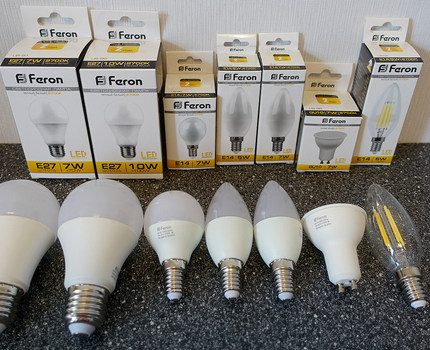
Chinese options without a trademark are quite affordable, but you should buy them with great care. Yes, and expect that cheap options will meet all parameters and will last a long time, not worth it. Price reduction is achieved by saving on components, which, of course, adversely affects the quality of products.
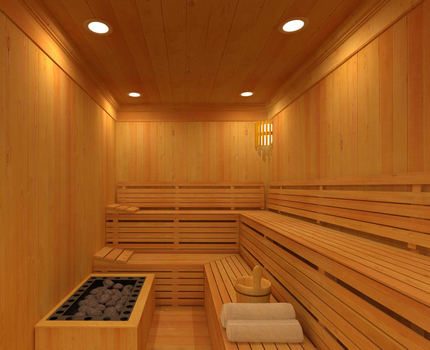
In addition, LED products cannot work correctly with switches equipped with diode illumination. They flicker or begin to glow weakly when the keys of the device are in the off state and create inconvenience for people who are in the room at this time.
Top list of the best manufacturers
The market of progressive LED equipment is full of offers from various brands. In the segment lamps for ceiling lighting several brands that have proven themselves in the production of reliable, high-quality, durable and environmentally friendly products occupy leading positions.
No. 1 - products of the brand Philips
Company Philips produces a wide range of LED lamps for ceiling lights. The range includes modules that differ from each other in power, light intensity, color temperature and energy efficiency.
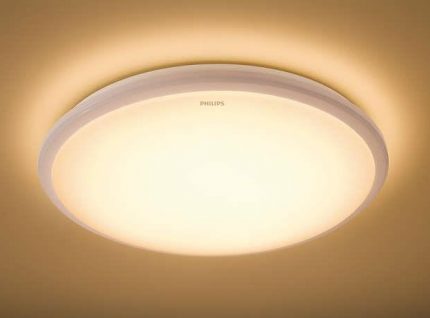
Philips products are considered to be one of the most reliable and environmentally friendly, almost always run out of service life declared by the manufacturer, and are sold for very reasonable money.
The manufacturer has official representations around the world, so buying a genuine original product from Philipps, and not a Chinese fake, is easy.
No. 2 - Osram LED modules
Products of a German company are no less popular. Osram. This is one of the oldest brands working in the manufacture of lighting equipment. It entered the market for the first time in the spring of 1906 and since then has been increasing production and providing customers with quality elements for comfortable, economical lighting.
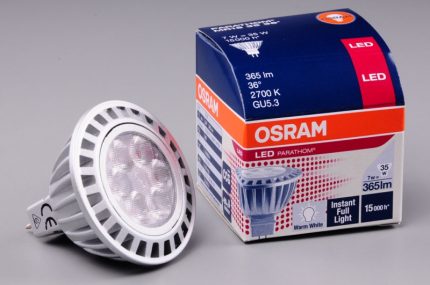
Today Osram is part of the industrial sector of the international concern Siemens and is considered one of the leading manufacturers of innovative high-level lighting products.
The annual turnover of the company exceeds 5 billion euros. The lamps of the German brand are produced at 48 modern enterprises located in 17 countries of the world. The brand spends 5% of all profits on progressive research that contributes to the improvement of LED products.
No. 3 - lamps from Foton Lighting
Foton Ligting Ltd is located in London. It produces and sells various types of elements needed for modern lighting systems. The priority of the brand is the manufacture of advanced, innovative and high-tech products.
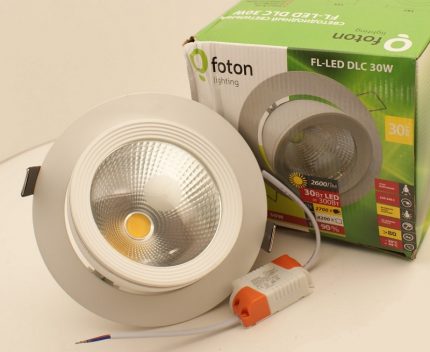
The assortment series is very wide and includes both basic standard models and creative products that satisfy the most extraordinary customer requirements for lighting systems.
No. 4 - Vatron's Gauss products
Brand name Gauss owned by a young but very promising Russian company, Vatron, founded in 2009 by Denis Frolov, the former director of development of Wimm-Bill-Dan Corporation. At the dawn of its founding, the company, under the Gauss personal brand, was selling compact Chinese fluorescent lamps.
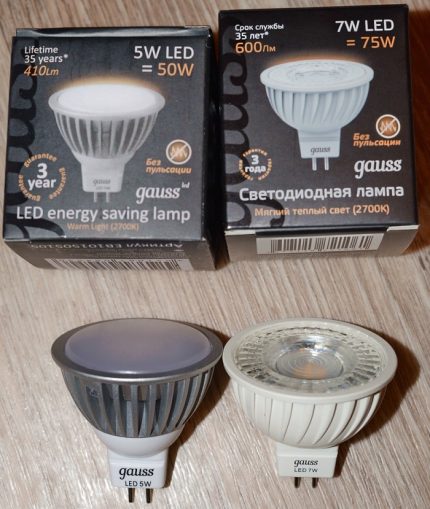
In 2010, Vatron acquired a co-owner, Ilya Sivtsev. A little later, both leaders decided to reorient themselves on the implementation of elements for LED lighting.
This thoughtful move brought substantial profit to entrepreneurs and allowed them to buy an abandoned factory in the Tula region to organize the production of their own LED products.
Effective investment in development, the creation of an advanced research laboratory and the organization of a research and production center allowed the company to begin producing progressive LED products.
By 2015, Vatron took control of about 18% of the domestic Russian market for lighting products and related components. Today, the company produces modules of various shapes and designs and does not give up leadership positions in the budget segment of LED products.
No. 5 - LEDs of the brand Kreonix
The Russian manufacturer of LED equipment and related components KREONIX Ltd offers customers about 400 types of progressive goods manufactured according to the basic needs of consumers.
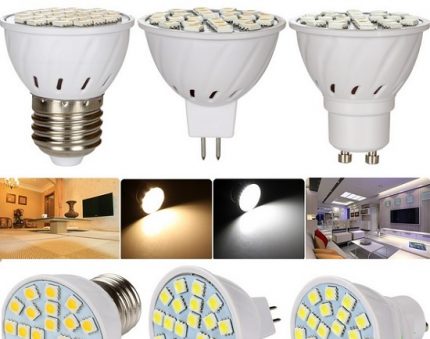
Modules are made in their own factory or purchased at popular and reliable Chinese plants, branded and sold in the domestic market under their own brand name.
Among the advantages of the products are the record-breaking economical consumption of electricians, the absence of flicker visible to the eye, and an impressive service life. As well as a modern, attractive and functional design that allows you to integrate Kreonix lamps into ceiling lights of any, even the most complex design.
With guidelines for the selection of all types of bulbs for spotlights next article, which we highly recommend reading.
Conclusions and useful video on the topic
Detailed and affordable description of LED lamps for ceiling lights. Recommendations for use.
A complete overview of LED bulbs for ceiling lighting. Pros and cons of models, differences in the material of which the base is made.
What is the advantage of an aluminum case over glass, plastic and ceramic.
Practical tips for choosing LED lamps for home use. What you need to pay attention to when buying. Which lamps are more suitable for ceiling lighting.
LED lamps designed to create a comfortable ceiling lighting that is safe and does not exert a load on the eyesight can be purchased in company stores.
The high cost is compensated for by a long service life and minimal electric consumption. Having bought LED modules, you will provide the home with high-quality light and for a long time forget about what a blown bulb is.
Please write comments, ask questions, post photos in the block below. Tell us about how you chose diode bulbs for suspended ceiling. Share useful information on a topic that may be useful to site visitors.

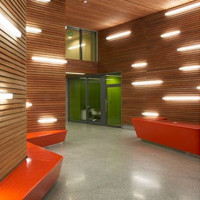 T8 LED lamps: characteristics, comparison with fluorescent + best manufacturers
T8 LED lamps: characteristics, comparison with fluorescent + best manufacturers 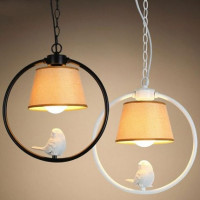 220V LED lamps: characteristics, marking, selection criteria + review of the best brands
220V LED lamps: characteristics, marking, selection criteria + review of the best brands 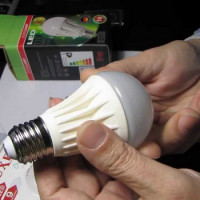 Which LED lamps are better to choose: types, characteristics, choice + best models
Which LED lamps are better to choose: types, characteristics, choice + best models 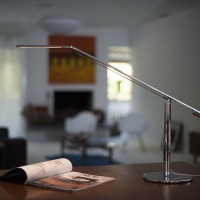 LED table lamps: types, selection rules + review of the best manufacturers
LED table lamps: types, selection rules + review of the best manufacturers 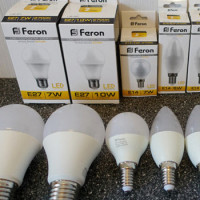 LED lamps "Feron": reviews, pros and cons of the manufacturer + best models
LED lamps "Feron": reviews, pros and cons of the manufacturer + best models  Bulbs for spotlights: types, characteristics, nuances of choice + best brands
Bulbs for spotlights: types, characteristics, nuances of choice + best brands  How much does it cost to connect gas to a private house: the price of organizing gas supply
How much does it cost to connect gas to a private house: the price of organizing gas supply  The best washing machines with dryer: model rating and customer tips
The best washing machines with dryer: model rating and customer tips  What is the color temperature of light and the nuances of choosing the temperature of the lamps to suit your needs
What is the color temperature of light and the nuances of choosing the temperature of the lamps to suit your needs  Replacement of a geyser in an apartment: replacement paperwork + basic norms and requirements
Replacement of a geyser in an apartment: replacement paperwork + basic norms and requirements
When we changed the old kitchen, we installed a stretch ceiling at the same time as the new one. To emphasize all the advantages of the color scheme of the new interior, we decided to use LED lamps for lighting. First, we saved money, bought lamps made in China and were very sorry. As they say, avaricious pays twice, or even three times. Ceiling LED lights can be great to beat the interior.